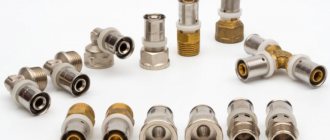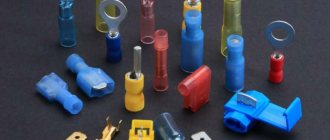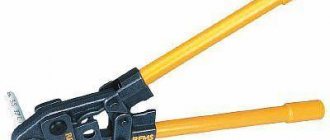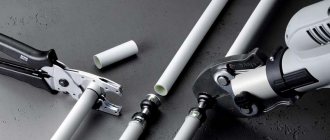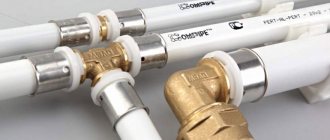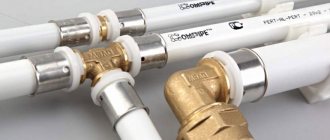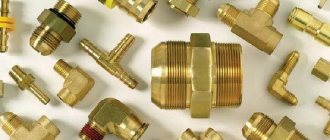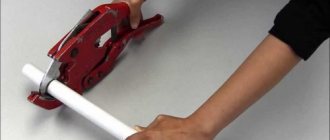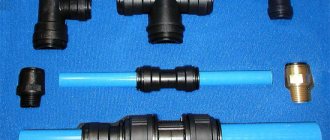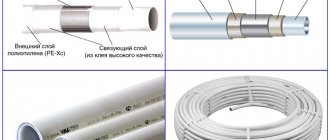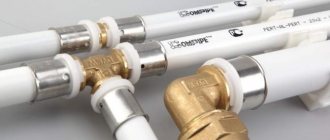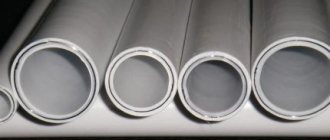The connection of metal-plastic pipes is made using compression fittings for clamping and their analogues for crimping. Installation of pipelines in both cases does not require sophisticated equipment or highly qualified specialists.
The first method is easier to implement, but not as reliable. But press fittings for metal-plastic pipes make it possible to create a durable system with minimal risk of rupture.
General description of couplings for crimping
A press fitting connection is one of the most reliable methods of joining metal-plastic pipes. As a result of this installation, the pipeline turns out to be one-piece, but very reliable. If after assembly you need to change its circuit, you will have to redo a lot from scratch, but leaks are practically excluded.
The reliability of the press connection is ensured by crimping the pipe around the fitting fitting with a special stainless steel sleeve. If the pipe needs to be replaced, the pressed section will need to be cut out
Press fittings are a permanent type of connection, obtained in this case by compressing a metal sleeve around an o-ring. In this case, as a result of the crimping performed, the ring is irreversibly deformed. It cannot be removed and then reused. The geometry of the pipe itself also changes slightly.
For metal-plastic pipes, fittings for crimping are made from:
- brass;
- of stainless steel.
The first option is more preferable. It is more reliable and durable in conditions of high humidity.
Unscrupulous manufacturers often use aluminum and other soft metals to make the fittings in question. They can be easily identified by weight. Brass is obviously heavier in the hands than these fakes. It is strictly not recommended to use such products for crimping metal-plastic pipes. By definition, they are not able to tightly compress the fitting and pipe plastic.
Fittings for press connections and metal-plastic pipes for installation of intra-house pipeline systems should be taken from the same manufacturer, otherwise you can forget about the absolute reliability of the joint
Each manufacturer of metal-plastic pipes recommends purchasing its own set of press fittings. And for good reason. Pipe products and fittings from different manufacturers can vary in diameter by literally a millimeter. Quite a bit, but this is enough to reduce the reliability of the connection. It’s better not to save money here, risking a break and leakage.
There is no single standard for the outlines and exact dimensions of fittings. Each manufacturer independently selects these parameters for their products. Some sellers offer universal press fittings, but this is a banal advertising ploy. The use of such connecting parts is inevitable and will result in leaks in the near future after installation.
Application
The scope of use is quite wide. Products of this type can be installed at different facilities: private and industrial. They are installed when laying pipelines in multi-storey buildings, private houses, and utility networks. The transported medium may be different:
- water (when installing a heating system, drainage system, water supply system);
- gaseous substances, incl. steam;
- petroleum products.
The use of crimping products is justified when installing pipelines with different characteristics. So, they can be installed in corner areas, when moving from one diameter of communications to another, etc.
Types of press fittings for metal-plastic pipes
The connecting elements in question on the plumbing market are presented:
- crosses;
- tees;
- squares;
- couplings with a union nut;
- adapters with external and internal threads.
Such a variety of models allows you to assemble a metal-plastic pipeline of any configuration and purpose. There are no restrictions here.
In terms of the shape of the second end and purpose, fitting couplings for pipes made of metal-plastic are no different from connecting parts for pipe products made of other materials
According to the method of crimping the sleeve, press fittings are divided into crimp and push-in. In the first case, the ring is crimped with special pliers. In the second, it is pulled onto the fitting using a hydraulic or manual press.
Type #1: Crimp
The sleeve on such a press fitting can be a separate element or a part immediately attached to the body. Crimping it after fitting the metal-plastic pipe onto the fitting is carried out using pliers. This tool is specialized and is not intended for other purposes. It can be used exclusively for installing pipelines by squeezing a metal ferrule.
The press connection tool comes with several attachments for pipes of various diameters; you don’t need to purchase two or three pliers
Installation of metal-plastic pipes using crimp press fittings is carried out as follows:
- The pipe of the required size is cut using a pipe cutter.
- An internal chamfer is removed from the end of this segment.
- To get rid of ovality, which occurs as a result of squeezing the plastic with a cutting tool, a gauge is used.
- A crimp ring is placed on the pipe.
- A dielectric gasket and O-rings are placed on the fitting, and then it is pressed into the pipe.
- The metal coupling is crimped using press jaws.
If everything is done correctly, then two pronounced depressed stripes should form on the ring along the entire circumference. Moreover, these zones of maximum compression should not coincide with the places where rubber O-rings are located on the fitting. When performing crimping, it is extremely important to avoid the formation of excess stress in the sealant material. It should not be excessively compressed.
To avoid electrocorrosion, press fittings for metal-plastic pipes are equipped with a dielectric gasket, which prevents direct contact of aluminum with the metal of the fitting
Sealing gaskets are designed to compensate for temperature deformations in the pipe walls. If you squeeze them when crimping a press fitting, the rubber will lose its elastic properties, and then when the water temperature changes, the plastic will gradually begin to collapse. As a result, instead of the 20–30 years declared by manufacturers, the press connection will last 5–10 at most.
The pipe must be pushed onto the fitting until it stops. To prevent the plumber from making a mistake here, many crimp couplings have small holes through which the white plastic is clearly visible. You just need to apply a little force and then crimp the fitting with pliers. The resulting connection can be safely embedded in concrete. It will last as long as the metal-plastic pipes themselves without leaks.
Type #2: Press-on (slide-on)
The second version of press fittings does not involve compressing the ring, but pulling it onto the pipe into which the fitting is inserted. Such a connection is no less strong than in the first case with crimping. Only for the installation of metal-plastic pipes with fittings using the pressing method, not pliers, but a special press are used.
The use of compression and push-in press fittings virtually eliminates errors when assembling the pipeline; there is simply nothing to tighten too tightly or too loosely
To connect metal-plastic pipes with press fittings, you need to perform four steps in sequence:
- Place a metal ring on the pipe.
- Expand the diameter of the pipe by treating its end with an expander.
- Insert the fitting into the place intended for it until it stops.
- Clamp the sliding coupling with the press jaws and press it onto the fitting.
This method involves using, in addition to a press tool, an expander. It is designed to expand the pipe at the cut point. Without this, it is impossible to pull it onto the fitting. All diameters are calculated in such a way that it is impossible to do this manually without prior preparation.
The reliability of the connection is ensured on the one hand by a sliding ring, and on the other by the properties of cross-linked polyethylene from which metal-plastic pipes are made. After expansion and attachment to the fitting, this plastic tries to return to its original dimensions. There is an inevitable and tight compression of the fitting connector. And from above all this is still tightened with a metal ring.
Tools for crimping press connections should only be used that are recommended by the manufacturer of metal-plastic pipe products - the tightness of the connections depends on this
For the installation of push-on press fittings, the tool is available both manually, battery-powered, and electric from the mains. If you have to connect a lot of pipes, then you should choose the second option. For one-time work, a cheaper manual analogue is quite sufficient. There is no special effort required when crimping this fitting.
Correspondence of diameters of steel and polypropylene pipes (table)
When replacing an old pipeline, increased attention is paid to the ratio of the diameters of metal and polypropylene pipes. After all, the outer diameter of the polymer pipe can be 16-110 mm. At the same time, have different wall thicknesses.
At the same time, rolled steel pipes are manufactured with a different outer cross-section and the same internal diameter as PP pipes.
It is also worth knowing that the labeling of polymer products does not indicate the internal diameter. However, it is not difficult to calculate it when the outer section and wall thickness are known. The difference between these values will correspond to the desired value.
When replacing old steel utility lines with a polypropylene system, it is important to consider the following:
- Metal pipes for water supply and gas networks have an internal surface that is not perfectly smooth, which reduces throughput.
- Rolled metal pipes are available in lightweight and reinforced versions. Each type of pipe has a different wall thickness. In other words, with the same cross-section along the outer edge, pipe products will have different internal diameters. This is what is taken into account when the utility network is replaced.
- Metal and PP pipes are created according to different GOSTs. Therefore, to select polymer pipes, you need to know all the characteristics of plastic products.
Table of correspondence between the diameters of polypropylene pipes and steel
Differences from compression analogues
Due to inexperience and ignorance of all the nuances of installing metal-plastic pipes, press fittings can be confused with compression fittings. They also have a fitting and a sleeve. Only the latter is crimped not with a tool, but using the union nut included in the design.
The main difference between these parts is the different type of connection resulting from installation. The compression version can be disassembled if necessary, but this cannot be done with a pressed version. The press fitting can only be cut off from the pipe to be replaced with a new one.
If a leak develops at the connection point, the nut of the compression fitting can be tightened, but the maintenance-free press fitting will have to be completely removed
However, the likelihood of a leak in the press connection is practically zero. It is not for nothing that this installation method is recommended for use when installing “warm floors” under a screed and when embedding pipelines into the wall. Cases when such fittings begin to leak in concrete occur extremely rarely in the practice of plumbers. This is more of an exception to the rule.
On the other hand, installation of both types of press fittings requires specialized tools. And to tighten the nuts of compression products, you only need a pair of wrenches. As a result, on one side of the scale there is “expensive instrumentation + higher reliability of the joint”, and on the other “no extra expenses + a slightly higher risk of leaks”. The choice here is only up to the master and the owner of the house where the pipeline is being laid.
How it's done?
Once it becomes clear what needs to be done, the methods become obvious.
When crimping, the following operations are performed sequentially:
- The pipeline section is hermetically sealed off from other engineering systems . The choice of method is individual for each case. The valves in the elevator assembly are closed, and the heating system ring is cut off by valves. In the case of sewerage, pneumatic rubber plugs are used.
They look like this
Advice: in, so to speak, field conditions for plastic sewers, you can get by with ordinary plugs for outlets, which are sealed with an O-ring.
Of course, their use implies a slight excess pressure. For a cast iron sewer, you can simply cut out a wooden chopper and wrap it with rags.
- A pipe pressure testing pump is connected to the pipeline being tested . This device can be manual, electric, or have its own internal combustion engine. The choice of a specific device depends on the required pressure and the volume of the pipeline.
Thus, to pressure test the heating system of a private house, a simple hand pump with a capacity of 3 liters per minute can be used; For pressure testing of heating mains with their volumes, the same pumps are used that provide circulation in them.
Before us is the simplest manual crimping machine
Important: hydraulic tests are carried out only with cold water. This is simply related to work safety.
Where leaks are absolutely unacceptable, air pressure testing can be carried out: however, in this case, the pressure drop in the pipe during leaks has to be monitored over a long period of time.
Air, unlike water, is compressible.
You can also pressurize the pipe with air. But it's much longer
- Water is injected into the pipeline being tested at a pressure exceeding the design operating pressure . For systems made of heating and water supply pipes, this is usually 6-8 kgf/cm2. For heating mains and main water pipelines 10-12 kgf/cm2. Cast iron sewerage is checked with an excess pressure of no more than 2 atmospheres, plastic - no more than 1.6.
The presence of leaks can be easily monitored by the pressure drop: even the cheapest pipe pressure tester is equipped with a pressure gauge.
Where possible, it is better to check for leaks visually. If there are leaks, after they have been eliminated, repeated pressure testing is carried out.
Features of installation and selection of fittings
Metal-plastic pipes made of cross-linked polyethylene are not initially intended for welding and gluing. The welds on them will still crack and come apart after a couple of months. And glue is not used due to the resistance of this plastic to solvents and its low adhesion. It remains to use only specialized fittings for installation.
All cuts of metal-plastic pipes must be made exclusively at an angle of 90 degrees; even minor deviations can have a detrimental effect on the quality of the connection
When choosing a press fitting, the main attention should be paid to the crimp ring. It must be made of durable metal. And no seams on this metal surface, just seamless stamping. Any seam is a point for destruction. It is better to immediately reduce or completely eliminate the likelihood of a pipeline rupture resulting in flooding of the house. There's no point in chasing cheap prices here.
The standard sizes of the press fitting are indicated in the markings both on the ring and on its body. Similar information is contained on the pipe. Everything must match. Once again, you should not purchase fittings and pipes made of metal-plastic from different manufacturers. In most cases, such inconsistency leads to problems both at the installation stage and then during operation.
After crimping the fitting, the pipe must not be bent near the latter. This may place unnecessary stress on the connection. It is also unacceptable to apply any lateral force to the press fitting. It itself will not be damaged, but the plastic nearby may collapse.
Ease of purchase
The Vertex Thermoline company offers to buy galvanized pipes and fittings, presented in a wide range. The length of products ranges from 150 cm to 12 m, we offer delivery services in the shortest possible time throughout Moscow and the region. Direct cooperation with product manufacturers guarantees unsurpassed quality, affordable prices, and low delivery costs. The pages of the catalog also present galvanized fittings in all the variety of their modifications - crosses, couplings, barrels, tees, elbows, American fittings, locknuts, bends, fittings. Galvanized fittings are divided into threaded, crimp, and flange.
When choosing pipes, pay attention to their technical and operational characteristics - thickness, length, diameter, which determines their scope of application. Our employees will be happy to provide all the necessary information, which is duplicated on the pages of the catalog. We provide individual terms of cooperation and a variety of payment methods to each client.
Assembling a copper pipeline by soldering
The greatest tightness can be achieved by connecting pipes using the soldering method. When performing work, you must strictly follow the recommended safety rules.
Tools
To assemble the pipeline using the soldering method, you will need the following set of materials and tools:
- copper pipes, the number and diameter of which are determined according to the diagram;
- pipe cutter (in the absence of a device, you can use a regular hacksaw);
- pipe bender;
- metal brush for preparing the pipe for soldering;
- sandpaper (used in addition to the brush);
- pipe expander - a special device for increasing the diameter of one of the connected pipes;
- gas-burner;
- chamferer (device for removing burrs after cutting pipes);
- a flux composition that allows for additional cleaning of pipes and promotes a more uniform distribution of solder;
Types of flux for soldering
Solder is a metal alloy that is used to fill the space between pipes during the soldering process.
Types of solder for different types of soldering
Flux and solder are selected depending on the type of soldering (low-temperature or high-temperature), and the flux and solder must match each other as much as possible.
Soldering process
How to connect copper pipes by soldering? To obtain a strong connection, it is recommended to adhere to the following scheme:
- pipes are cut. The length of each section of the pipeline must correspond to the diagram, which indicates the copper pipe distribution throughout the residential premises;
Cutting pipes with a pipe cutter
- the ends of the pipes are chamfered. Then the areas for soldering are cleaned until the surface is as smooth as possible and cleaned of oxides and other contaminants using a metal brush;
Preparing the pipe surface for soldering
- to achieve maximum tightness of the solder joint, the end of one pipe must be widened by 2 mm - 3 mm;
Increasing pipe diameter
- The place of future soldering is treated with flux. Since the chemical composition can negatively affect the skin of the hands, work is carried out with protective gloves. Flux in the form of a paste is most conveniently applied using a small brush;
Applying flux to a section of pipe
- the burner warms up to the required operating temperature;
- the flux melts a little;
- pipes are connected;
- excess flux is removed with a dry soft cloth;
- soldering is done. Solder is smoothly applied to the heated area, which melts when heated and fills all the free space;
Filling with solder during soldering process
- for 3 – 5 minutes (until it cools completely) the connection is left motionless;
- the next section of the pipeline is connected in a similar way.
Soldering of pipes is carried out at high temperatures. In addition, harmful substances are often released during work. Therefore, the pipeline assembly by soldering must be done in a well-ventilated area and away from flammable substances or objects.
Possible methods for installing copper pipes are discussed in detail in the video.
After preliminary assembly, copper pipes are laid according to a previously developed diagram. To secure the pipeline, you can use a clamp, bracket or other devices. In addition, pipes can be laid in walls.
What material are crimp tubes made of?
Which material used to make crimp tubes is more reliable? According to experienced fishermen, brass and copper have the best characteristics. The latter material is plastic and easy to process. For example, aluminum tubes quickly crack, and steel crimp tubes crush the fishing line (unwinding material), but are excellent for sea fishing.
The material for the crimp tube must be plastic and this is the main requirement for it.
We bring to your attention an interesting article about the diverter leash, types of installations, wiring and much more - here
Connection technique
Thin-walled steel pipes and fittings
The KAN-therm Steel system consists of thin-walled steel pipes and various configurations of fittings connected using press technology.
The KAN-therm Steel system is based on the technique of making crimp connections “Press” - crimping using the M crimp profile, which allows:
- create a three-point crimp of the O-Ring type seal, ensuring its appropriate deformation and tight fit to the surface of a thin-walled steel pipe,
- Completely enclose the space in which the O-Ring seal is inserted by pressing the edge of the fitting against the surface of the pipe, which prevents contamination from entering the fitting and provides a natural mechanical protection for the seal, as well as strengthening the mechanical connection.
